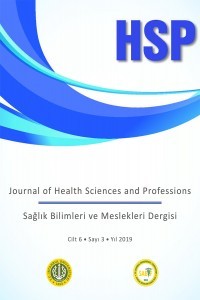Ameliyathanelerde Cerrahi Dumanın Etkileri ve Korunmaya Yönelik Alınan Önlemler
cerrahi duman, ameliyathane, hemşire
The Effects of Surgical Smoke in Operating Rooms and Precautions for Protection
surgery plume, operating room, nurse personnel,
___
- 1. Okoshi K, Kobayashi K, Kinoshita K, Tomizawa Y, Hasegawa S, Sakai Y. Health risks associated with exposure to surgical smoke for surgeons and operation room personnel. Surg Today. 2015; 45 (8): 957–65. DOI: 10.1007/s00595-014-1085-z
- 2. Edwards BE, Reiman RE. Results of a survey on current surgical smoke control practices. AORN J. 2008; 87(4): 739-49. DOI: 10.1016/j.aorn.2007.11.001
- 3. Ulmer BC. The hazards of surgical smoke. AORN J. 2008; 87(4): 721-34. DOI: 10.1016/j.aorn.2007.10.012
- 4. Fencl JL. Guideline implementation: surgical smoke safety. AORN J. 2017; 105(5): 488-97. DOI: 10.1016/j.aorn.2017.03.006
- 5. Yavuz van Giersbergen M, Şahin Köze B. Ameliyathanede İş Ortamı Kalitesi; Cerrahi Duman- Literatür Taraması. Öğce F, Candan Dönmez Y, Çelik B, Turhan Damar H, editörler. 2.Uluslararası 10.Ulusal Türk Ameliyathane ve Cerrahi Hemşireliği Kongresi; 2-5 Kasım 2017; Antalya, Türkiye. İzmir: Metabasım Maatbacılık Hizmetleri; 2017. s. 553.
- 6. Yavuz van Giersbergen M. Cerrahi duman. İçinde: Yavuz van Giersbergen M, Kaymakçı Ş, editörler. Ameliyathane Hemşireliği. İzmir: Metabasım Matbaacılık Hizmetleri; 2015. s. 245-52.
- 7. Choi DH, Choi SH, Kang DH. Influence of surgical smoke on indoor air quality in hospital operating rooms. Aerosol and Air Quality Research. 2017; 17(3): 821-30. DOI: 10.4209/aaqr.2016.05.0191
- 8. Carbajo-Rodríguez H, Aguayo-Albasini JL, Soria-Aledo V. Surgical smoke: risks and preventive measures. Cir Esp. 2010; 85(5): 274-79. DOİ: 10.1016/j.ciresp.2008.10.004
- 9. Hahn KY, Kang DW, Azman ZA, Kim SY, Kim SH. Removal of hazardous surgical smoke using a built-in-filter trocar: a study in laparoscopic rectal resection. Surgical Laparoscopy Endoscopy & Percutaneous Techniques. 2017; 27(5): 341–45. DOI: 10.1097/SLE.0000000000000459
- 10. Occupational Safety and Heath Administration-OSHA. Laser/Electosurgery Plume. [Cited: 16.02.2018]. Available from: https://www.osha.gov/SLTC/laserelectrosurgeryplume/
- 11. The Association of periOperative Registered Nurses- AORN. Recommended practices for laser safety in the perioperative practice settings. In: Perioperative Standarts and Recommended Practices. Denver: AORN; 2013. s. 143-56.
- 12. The Association of periOperative Registered Nurses AORN. Recommended Practices for Electrosurgery. In: Perioperative Standarts and Recommended Practices. Denver: AORN; 2013. s. 125-41.
- 13. ECRI Institute. Laser Use and Safety. [Updated: 26.09.2017; Cited: 16.02.2018] Available from: http://ceeducation.org/Documents/3-Lasers/ECRI-SurgAn17.pdf
- 14. American National Standards Institute-ANSI. ANSI Z136.4-2010: American National Standard Recommended Practice for Laser Safety Measurements for Hazard Evaluation. 2010. LIA: Laser Institute of America Orlando.
- 15. Sağlık Hizmetleri Genel Müdürlüğü Sağlıkta Kalite ve Akreditasyon Daire Başkanlığı. Sağlık Hizmetleri. İçinde: Sağlıkta Kalite Standartları Hastane. 2. Baskı. Ankara: Pozitif Matbaa; 2016. s. 229-37.
- 16. Carpenter H, Murphy Dawson J. Evaluating perioperative nurses’ health, safety, and wellness. AORN J. 2017; 105(3): 7-9. DOI: 10.1016/S0001-2092(17)30116-3
- 17. Ball K. Compliance with surgical smoke evacuation guidelines: ımplications for practice. AORN J. 2010; 92(2): 142-49. DOI: 10.1016/j.aorn.2010.06.002
- 18. Yavuz M, Kaymakçı Ş, Özşaker E, Dirimeşe E, Okgün A. Ameliyathanede cerrahi duman riskleri ve alınan önlemlerin incelenmesi. 2010. [Erişim Tarihi: 04.09.2015] Erşim Adresi: https://www.turkcer.org.tr/files/17_UCK_Bildiri_Ozetleri/CONTENT/HS58.htm
- 19. Okgün Alcan A, Yavuz van Giersbergen M, Tanıl V, Dinçarslan G, Hepçivici Z, Kurcan Ç, et al. Bir üniversite hastanesinde cerrahi duman riskleri ve koruyucu önlemlerin incelenmesi [Investigation of surgical smoke and preventive measures in an university hospital]. Ege Üniversitesi Hemşirelik Fakültesi Dergisi. 2017; 33(2): 27-35.
- 20. İlçe A, Yüzden GE, Yavuz van Giersbergen M. The examination of problems experienced by nurses and doctors associated with exposure to surgical smoke and the necessary precautions. J Clin Nurse. 2017; 26(11-12): 1555–61. DOI: 10.1111/jocn.13455
- 21. Kenndy L. Implementing AORN recommended practices for a safe environment of care, part II. AORN J. 2014; 100(3): 281-93. DOI: 10.1016/j.aorn.2014.05.013
- 22. Dobbie MK, Fezza M, Kent M, Lu J, Sraceni ML, Titone S. Operation clean air: implementing a surgical smoke evacuation program. AORN J. 2017; 106(6): 502-12. DOI: 10.1016/j.aorn.2017.09.011
- 23. Okgün Alcan A. Cerrahi Duman. Öğce F, Candan Dönmez Y, Çelik B, Turhan Damar H, editörler. 2.Uluslararası 10.Ulusal Türk Ameliyathane ve Cerrahi Hemşireliği Kongresi; 2-5 Kasım 2017; Antalya, Türkiye. İzmir: Metabasım Maatbacılık Hizmetleri; 2017. s. 57-60.
- 24. Yasak K, Vural F. İzmir İlindeki Ameliyathanelerin Fiziksel Ergonomik Durumlarının İncelenmesi. Öğce F, Candan Dönmez Y, Çelik B, Turhan Damar H, editörler. 2.Uluslararası 10.Ulusal Türk Ameliyathane ve Cerrahi Hemşireliği Kongresi; 2-5 Kasım 2017; Antalya, Türkiye. İzmir: Metabasım Maatbacılık Hizmetleri; 2017. s. 410.
- 25. Joyce C. Surgical masks and exposure protection in the perioperative setting. AORN J ., 2018; 107(2): 253-56. DOI: 10.1002/aorn.12048
- 26. Anderson R, Bradley D, Etzkin J, Turner Pye, NN, Lane DL, Brooks BC, et al. Staff Compliance With Smoke Evacuation in the Operating Room AORN J. 2017; 105(6): 561-63. DOİ: 10.1016/j.aorn.2017.04.012
- 27. Ünver S, Yıldızeli Topçu S, Yıldız Fındık Ü. Surgical smoke, me and my circle. International Journal of Caring Sciences. 2016; 9(2): 697- 703.
- ISSN: 2148-7588
- Başlangıç: 2014
- Yayıncı: İstanbul Üniversitesi-Cerrahpaşa
Yonca ZENGİNLER, Buket AKINCI, Tülin ALTINOLUK
Betül SÖNMEZ, Merve ÖNAL, Gözde YILDIZ
Kadınların Gebeliği Algılama Durumu ve Bunu Etkileyen Faktörler
Sedef ARSLAN, Gülşen OKÇU, Anahit M. COŞKUN, Fatma TEMİZ
Alkolizmin Aile ve Çocuk Üzerine Etkisi
Sağlık Bilimleri ve Meslekleri Dergisi Cilt 6 Sayı 1 Yıl 2019
Sağlık Bilimleri Ve Meslekleri Dergisi HSP
Sezaryen Doğum Kararına Ebe Farkındalığı İle Etik Yaklaşım
Barsak Mikrobiyotası ve Dayanıklılık Egzersizleri
Ameliyathanelerde Cerrahi Dumanın Etkileri ve Korunmaya Yönelik Alınan Önlemler
Esra USTA, Dilek AYGİN, Havva BOZDEMİR, Nursen UÇAR
Hemşire-Hemşire İşbirliği Ölçeği’nin Geçerlik ve Güvenirliği
Elif TEMUÇİN, İlknur Dolu, Maral KARGIN
